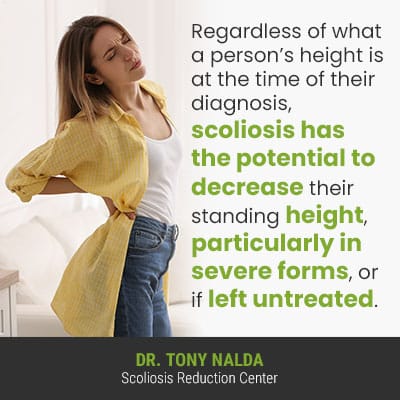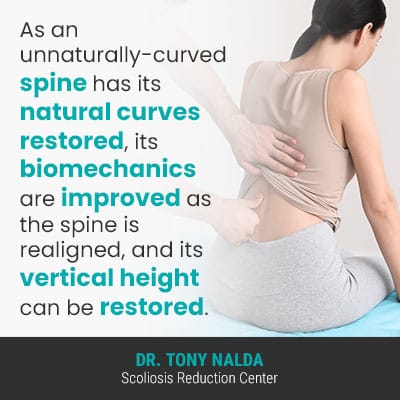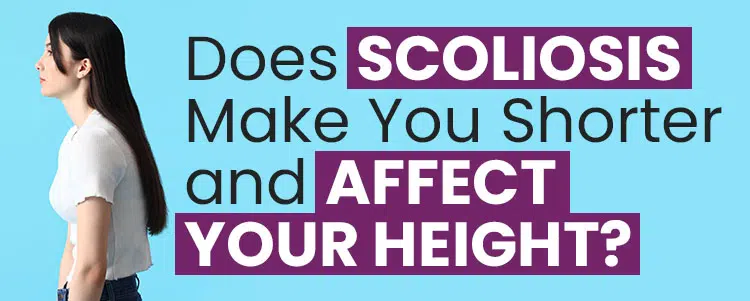Scoliosis is a complex condition, not just because it ranges greatly in severity from mild to moderate and severe to very severe, but also because there are different types of scoliosis with unique symptoms and treatment needs. Scoliosis can make you shorter and affect your height by causing a loss of the spine’s healthy curves and alignment, impacting a person’s ability to stand up straight and fully extend their spine.
As scoliosis is an unnatural sideways spinal curve, with rotation, the condition introduces a lot of uneven forces to the body. Those uneven forces can disrupt the body’s overall symmetry, and when it affects posture and the ability to stand up straight, a person can lose trunk height.
Let’s start our discussion of scoliosis and height by first exploring the connection between spinal anatomy and height in general.
4 Key Takeaways
- Impact of Scoliosis on Height: Scoliosis can affect a person’s height by causing a loss of the spine’s healthy curves and alignment. This impact varies with the condition’s severity, type, and whether it has been treated effectively.
- Spinal Anatomy’s Role: Understanding spinal anatomy, including the importance of maintaining the spine’s natural curvatures, is key to recognizing how scoliosis can affect height and overall posture.
- Scoliosis Severity and Types: Different types of scoliosis, such as adolescent idiopathic, neuromuscular, and degenerative, have unique impacts on height, with certain types posing a higher risk for height reduction.
- Restoring Height Through Treatment: Successful scoliosis treatment can potentially restore some height lost to scoliosis by realigning the spine and reducing the curvature. This involves proactive, multifaceted treatment approaches focused on structural correction and strengthening the supporting muscles.
Spinal Anatomy and Height
The spine is made up of vertebrae (bones of the spine) stacked on top of one another in a straight and neutral alignment, and most people have 33.
If a healthy spine is viewed from the front or back, it will appear straight, and if viewed from the sides, it will have a soft ‘S’ shape. It’s these natural spinal curves that help facilitate strength, flexible movement, absorb/distribute mechanical stress, and the ability to stand upright and practice good posture.
The vertebrae are separated by intervertebral discs, and these discs help facilitate the spine’s flexibility, provide cushioning between adjacent vertebrae, give the spine structure, and act as its shock absorbers.
The health of the spinal discs is important for optimal spinal health and function, particularly in terms of spinal degeneration as the discs stop adjacent vertebrae from rubbing up against each other, causing friction and spinal degeneration.
If the spine loses one or more of its healthy curves, the spine’s overall health and function is disrupted.

Regardless of what a person’s height is at the time of their diagnosis, scoliosis has the potential to decrease their standing height, particularly in severe forms, or if left untreated.
So let’s move on to discussing the severity levels of scoliosis and related symptoms such as a loss of height.
Scoliosis and Severity
As mentioned, scoliosis develops across a wide severity spectrum from mild to moderate and severe to very severe.
A measurement known as Cobb angle places conditions on a severity scale and involves drawing intersecting lines from the tops and bottoms of the most-tilted vertebrae at the apex of the curve:
- Mild scoliosis: Cobb angle measurement of between 10 and 25 degrees
- Moderate scoliosis: Cobb angle measurement of between 25 and 40 degrees
- Severe scoliosis: Cobb angle measurement of 40+ degrees
- Very-severe scoliosis: Cobb angle measurement of 80+ degrees
You can see from the variance in Cobb angle degrees, that there is a wide range of severity levels, which is why I preface scoliosis discussions by saying that not all symptoms associated with the condition are going to be part of the experience. Each case is unique, and symptoms will be case-specific, as will treatment needs.
So while one patient might experience a loss of trunk height, not all will, particularly in mild forms.
Now that we’ve covered the different severity levels of scoliosis, let’s move on to some of the different condition types: idiopathic, neuromuscular, and degenerative.
Adolescent Idiopathic Scoliosis and Height
The condition’s most prevalent form is adolescent idiopathic scoliosis (AIS), diagnosed between the ages of 10 and 18.
The idiopathic designation means not clearly associated with a single-known cause; that’s not the same as saying there is a complete absence of a cause, and the condition is, instead, considered to be multifactorial, meaning caused by multiple variables that can vary from one patient to the next.
With AIS, it’s difficult to monitor how the condition affects height because this age group is in, or is entering into, the stage of puberty, marked by rapid and unpredictable growth spurts, so as a growing spine is experiencing a constant lengthening motion, the direct link between a loss of height and AIS is unclear.
Neuromuscular Scoliosis
When it comes to neuromuscular scoliosis (NMS), scoliosis develops as a secondary complication of a larger underlying neuromuscular condition/disease such as spina bifida, muscular dystrophy, or cerebral palsy to name a few.
My neuromuscular scoliosis patients are among the most complex to treat because the underlying cause of the scoliosis, the neuromuscular condition itself, has to guide the treatment approach.
Depending on severity, NMS can greatly affect height because severe forms can cause a person to become nonambulatory, meaning wheelchair-bound and unable to move on their own.
While being nonambulatory is not the same as an actual loss of height, it does impact a patient’s ability to stand upright, and once they become nonambulatory, the constant pressure on the spine from sitting can contribute to a loss of vertical spinal height over time.
An additional form of scoliosis known to affect height is degenerative scoliosis, the second most common form, after idiopathic scoliosis, to affect adults.
Degenerative Scoliosis
Degenerative scoliosis most commonly affects adults over the age of 40, and is more common in women due to changes in hormone levels and bone density related to menopause.
There is a natural degree of spinal degeneration expected with age, but lifestyle factors can also play a role in just how extreme those changes are.
For example, carrying excess weight, chronic poor posture, incorrectly lifting heavy objects, and a sedentary lifestyle can negatively impact spinal health and function, and when combined with natural age-related degenerative changes, lifestyle factors can increase the level of deterioration in the spine.
In most cases, it’s the spine’s intervertebral discs that are the first spinal structures to feel the effects of degeneration, and when one or more of the spinal discs start to deteriorate, it can lead to a loss of trunk height.
The discs consist of two main components: a tough and durable outer layer known as the annulus and a soft and gel-like interior known as the nucleus.
When a disc degenerates, it can lose height, which affects the positioning of adjacent vertebrae, the spine’s ability to maintain its natural curves, and scoliosis can develop as a result.
Because the intervertebral discs don’t have their own vascular supply, they can’t restore and repair themselves, and once they change shape and lose height, this can lead to a loss in the spine’s vertical height by disrupting the position of adjacent vertebrae.
Now that we know how scoliosis can affect the spine, in terms of its vertical height, what happens when successful treatment reduces a scoliotic curve?
Can Treatment Restore Height Lost from Scoliosis?
As we know, a scoliotic curve bends the spine unnaturally to the side, causing a loss of its healthy curves. This accounts for a loss of trunk height as the spine is no longer aligned; conversely, what happens to the spine’s vertical height after successful treatment?
Here at the Scoliosis Reduction Center®, I address scoliosis proactively by applying treatment as close to the time of diagnosis as possible; this ensures that I’m treating the unnatural curve while the condition is at its mildest, is the simplest to treat, prior to significant progression, and before the body has had time to adjust to its presence.
Through combining multiple condition-specific treatment disciplines such as chiropractic care, in-office therapy, custom-prescribed home exercises, and corrective bracing, a curvature reduction on a structural level can be achieved, and this tends to address related postural changes as well.
In addition, scoliosis-specific exercises (SSEs), when prescribed by a specialist, can improve brain-body communication for better body positioning and postural remodeling, such as being able to stand up straighter.

As an unnaturally-curved spine has its natural curves restored, its biomechanics are improved as the spine is realigned, and its vertical height can be restored.
While there’s no guarantee that all height lost can be regained, in many cases, a successful treatment that impacts scoliosis, first and foremost, on a structural level through a curvature reduction and spinal realignment, and an increase in core strength so the spine is optimally supported by its surrounding muscles, can increase trunk height.
Conclusion
So does scoliosis make you shorter and affect your height: yes, it can, but it isn’t guaranteed to do so.
In mild cases, when the scoliotic curve is small, it’s unlikely to cause noticeable functional deficits and/or cause overt postural deviation, including a loss of trunk height, but if that mild condition is left untreated, or not treated proactively and progresses, increasing condition severity is likely to cause the spine to lose some of its vertical height.
In addition, particular types of scoliosis, such as neuromuscular and degenerative scoliosis, are more related to a loss of height due to underlying neuromuscular conditions affecting the muscles and ligaments of the spine, and spinal deterioration that changes the height/shape of the spine’s intervertebral discs.
When it comes to restoring a scoliosis-related loss of height, this can be worked towards through proactive treatment that addresses the condition’s postural symptoms as the unnatural spinal curve is reduced on a structural level.
Here at the Scoliosis Reduction Center®, I help patients improve their quality of life with the condition by addressing it on multiple levels, and when successful, related postural changes can be addressed alongside a curvature reduction.





